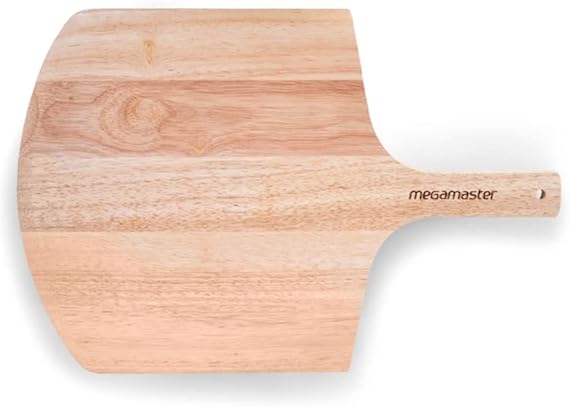Page Contents
Details: Megamaster Wooden Pizza Peel and Serving Board, Perfect Pizza Oven Accessory, Made from Eco-Friendly Bamboo, Durable and Heat Resistant, Easy to Transfer and Serve, 18 x 12 x 5 in., 530-0048P
Brand: Megamaster
The centerpiece of every pizza party, the Megamaster Pizza Peel and serving plank makes transferring your pizza on and off of heating surfaces easier than ever. Made from bamboo wood, this pizza peel is a must have pizza accessory. The wooden material has heat resilient inner linking for safe use.
Advantages
- Products can be returned
- Eco-Friendly Bamboo Construction: Crafted from sustainable bamboo, this pizza peel is an environmentally conscious choice for your kitchen. Bamboo is known for its durability and renewable properties, making this peel both functional and eco-friendly
- Multi-Functional Design: This pizza peel is designed to assemble, transfer, and serve your pie all from one convenient tool. It streamlines the cooking and serving process, allowing you to easily move your pizza from the oven or grill to the table without hassle
- Versatile Serving Board: Not just for pizza, this peel doubles as a serving board for a variety of foods, including bread, charcuterie, and appetizers. Its attractive design makes it perfect for entertaining guests, adding a stylish touch to your presentation
- Beveled Edge for Easy Transfer: The beveled edge is specially designed for easy transferring of pizzas without disturbing your toppings. This feature ensures a seamless slide from the peel to the serving surface, maintaining the integrity of your delicious creations
- Generous Dimensions: Measuring 18 inches long, 12 inches wide, and 0.5 inches thick, this peel provides ample space for large pizzas or multiple servings. Its sturdy construction supports heavy dishes without bending or breaking
Notice
- Is an online purchase
- Delivery may be delayed in some areas.
Buyer Guide For Patio Heaters
When shopping for a patio heater, several key factors should be considered to ensure you make the right choice. First, determine your heating needs by measuring your outdoor space and considering the climate you live in. Choose between propane, electric, or natural gas models based on your accessibility to fuel sources and convenience preferences. Propane heaters offer portability but require tank replacements, while electric models need proper outlets but are more environmentally friendly.Consider the BTU output (typically 40,000 BTU is sufficient for a standard patio) and the heating radius to ensure adequate coverage. Look for safety features such as automatic shut-off, tip-over protection, and weather resistance. Finally, factor in your budget, keeping in mind that while initial costs vary, fuel efficiency and durability can affect long-term expenses. Popular brands like Hampton Bay, Fire Sense, and AmazonBasics offer reliable options across different price points.
How to use Patio Heaters
Patio heaters are excellent solutions for extending your outdoor living space usage during cooler weather. Here’s a comprehensive guide on how to use them safely and effectively.Choosing the Right Location
- Place the heater on a flat, stable surface
- Keep at least 3 feet clearance from walls and flammable objects
- Avoid placing under covered areas with low clearance
- Ensure proper ventilation in the surrounding area
Starting and Operating
1. Connect the fuel source (propane tank or natural gas line) properly
2. Check for gas leaks before first use
3. Turn the control knob to “Pilot”
4. Press the ignition button to light the pilot
5. Once lit, adjust the temperature setting as needed
How to Maintain Patio Heaters
Regular maintenance of your patio heater ensures optimal performance and longevity. Start by cleaning the exterior with a damp cloth and mild soap. Check the gas connections for leaks using soapy water and look for bubbles. Clean the burner regularly to prevent blockages, and remove any debris or spider webs.Store your heater in a dry place during off-seasons, and always cover it when not in use. Replace the propane tank when needed and inspect the ignition system periodically. Check reflectors and heat shields for damage, and tighten any loose screws or fittings.
Remember to follow manufacturer guidelines and prioritize safety by keeping flammable materials away from the heater.




